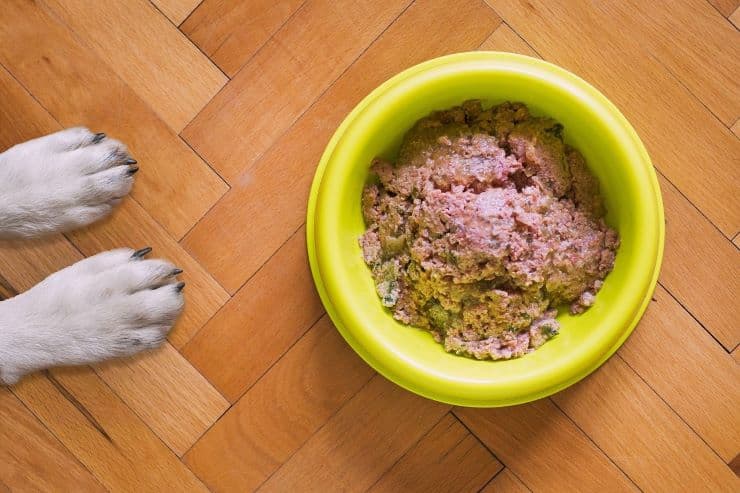Responsible pet owners are always trying to provide their furry friends with the best nutrition. Many of them stick to dog-friendly options like grain-free dog food, which not only caters to canines with sensitivities but also aligns with their evolutionary diet, promoting optimal digestion and overall well-being. Others prefer to offer their dogs a raw diet, which they consider to be more advantageous for the dogs' health and well-being than dry food.
In many cases, it can be true but it is always necessary to study which raw food is adapted to the needs of your dog.

Photo Credit: mattycoulton/Pixabay
Understanding the Basics of a Raw Diet
Before diving into the specifics, it's important to grasp the fundamentals of a raw diet. In essence, it involves feeding your dog uncooked, natural ingredients like meat, bones, and organs. Raw diets mimic what dogs would consume in the wild, promoting better digestion and nutrient absorption.
- Raw Meat Varieties: Diversify your dog's protein intake with various types of meat like chicken, lamb, turkey, and beef. Each type offers a different set of nutrients, contributing to a well-rounded diet. Incorporating different meats also reduces the risk of nutritional imbalances. Just keep in mind that some breeds like Shar Pei may be allergic to particular types of meat (beef, chicken) and should be preferably fed lamb or fish.
- Incorporating Edible Bones: Edible bones are a crucial component of a raw diet, supplying calcium and phosphorus essential for bone health. Ensure the bones are appropriate for your dog's size and breed. Avoid weight-bearing bones, as they may be too hard and pose a risk of dental fractures. The preferable bones are Chicken, Duck, or Turkey frames, heads, necks, and feet. If you want to use other chicken bones it is advisable to to chop them well in a food chopper.
- Organ Meats for Important Nutrients: Organs, particularly the liver and kidney, are nutritional powerhouses. The liver provides a rich source of vitamin A, while the kidney offers healthy minerals like zinc and selenium. Integrate these organs into your dog's diet to meet their specific nutrient requirements.
- Gradual Transition: When introducing a raw diet, transition gradually to prevent digestive upset. Start by mixing small amounts of raw food with their regular diet, increasing the ratio over a week or two. This allows their digestive system to adjust and ensures a smoother transition to the new diet.
Selecting Quality Ingredients
The foundation of a balanced raw diet lies in the quality of ingredients. Opt for fresh, human-grade meats, such as chicken, beef, or lamb. Including a variety ensures a spectrum of nutrients. Additionally, incorporate organs like the liver and kidney for essential vitamins and minerals. Avoid processed or seasoned meats, as additives can be harmful to your pet.
Introducing Fruits and Vegetables
While the focus is often on meat, don't overlook the benefits of incorporating fruits and vegetables that offer important vitamins, minerals, and fiber. Opt for dog-friendly options like carrots, blueberries, or spinach. Ensure they are finely chopped or pureed for easier digestion.
Maintaining the Right Ratios
Balancing proteins, fats, and carbohydrates is pivotal for your dog's health. Aim for a ratio of 70-80% meat, 10-15% organs, and 10-15% bone. This balance offers the necessary proteins for muscle development, fats for energy, and calcium from bones for overall bone health.
- Proteins (70-80%): The primary building block for your dog's muscles, proteins should form the majority of their diet. Include a variety of meats like chicken, turkey, and beef to provide a diverse amino acid profile.
- Organs (10-15%): Vital for supplying essential vitamins and minerals, organs such as the liver and kidney play a crucial role in maintaining overall health. Rotate different organ meats to offer a spectrum of nutrients.
- Bone (10-15%): Rich in calcium and phosphorus, bones contribute to strong teeth and bones. Ensure the bones are appropriate for your dog's size and are either ground or fed as edible bones to prevent choking hazards.
- Balancing Fats: While fats are included in the protein ratio, pay attention to the type and source of fats. Incorporate healthy fats like those found in fish oil for coat health and overall well-being. Adjust fat content based on your dog's activity level and weight.
Supplements for Comprehensive Nutrition
To cover all nutritional bases, consider adding supplements. Omega-3 fatty acids from fish oil support a healthy coat and skin, while calcium supplements can be crucial if your dog doesn't consume enough bone. Consult your vet to determine the specific needs based on your dog's breed, age, and health conditions.
Monitoring Your Dog's Health
Every dog is unique, and their nutritional requirements may vary. Keep a keen eye on your dog's weight, coat condition, and energy levels. If you notice any abnormalities, consult your vet promptly. Regular veterinary check-ups ensure your dog's diet aligns with their individual health needs.
Providing a balanced raw diet for your dog demands attention to detail and a commitment to their well-being. By understanding the basics, selecting quality ingredients, maintaining the right ratios, incorporating fruits and vegetables, adding necessary supplements, and monitoring their health, you can ensure your furry companion enjoys a vibrant and healthy life.
You may also like:
- Popular Russian Dog Breeds Adore Raw Dog Food
- Can You Feed a German Shepherd a Vegetarian Diet?
- How Much Raw Meat should I Feed my Rottweiler?

Leave a Reply